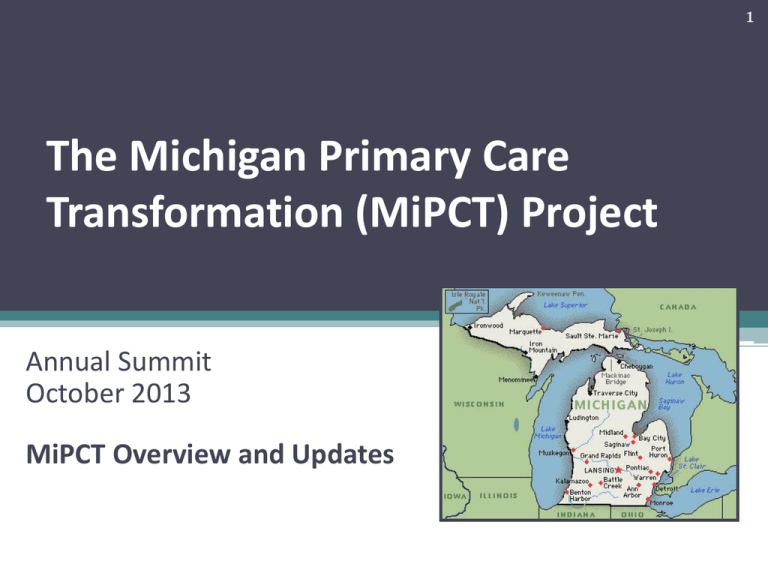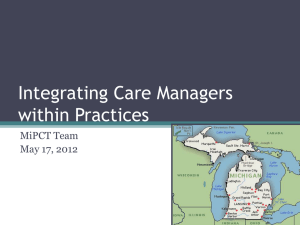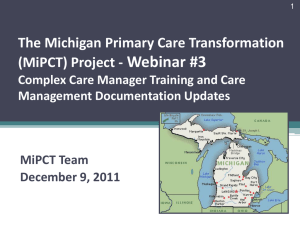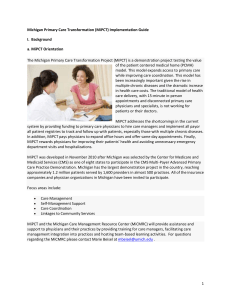MiPCT Evaluation Update
advertisement

1 The Michigan Primary Care Transformation (MiPCT) Project Annual Summit October 2013 MiPCT Overview and Updates Objectives • Recap MiPCT Overview and 2013/14 Focus Areas • Review MiPCT Project Evaluator Findings to Date • Discuss Project Sustainability MiPCT Overview Jean Malouin 4 CMS Multi-Payer Advanced Primary Care Practice (MAPCP) Demonstration • Centers for Medicare & Medicaid Services is participating in state-based PCMH demonstrations ▫ Assessing effect of different payment models • CMS Demo Stipulations ▫ Must include Commercial, Medicaid, Medicare patients ▫ Must be budget neutral over 3 years of project ▫ Must improve cost, quality, and patient experience • 8 states selected for participation, including Michigan • Michigan start date: January 1, 2012 Participants • • • • • 380 practices 35 POs 1,500 physicians 1 million patients 5 Payers ▫ Medicare ▫ Medicaid managed care plans ▫ BCBSM ▫ BCN ▫ Priority Health (7/13) 6 MiPCT Funding Model $0.26 pmpm $3.00 pmpm*, ** $1.50 pmpm*, ** $3.00 pmpm*, ** $7.76 pmpm Administrative Expenses Care Management Support Practice Transformation Reward Performance Improvement Total Payment by non-Medicare Payers*** * Or equivalent ** Plans with existing payments toward MiPCT components may apply for and receive credits through review process *** Medicare will pay additional $2.00 PMPM to cover additional services for the aging population 4 8 MiPCT Mid-Point: Statewide Care Management Progress to Date • Over 300 Care Managers hired and trained • Building infrastructure in partnership with POs ▫ ▫ ▫ ▫ ▫ CM Documentation tools Ongoing Care Manager training, coaching, mentoring Patient education materials Communication- PCP, CM, staff members Interface with community resources • Building volume of G code and CPT codes submitted • Building caseloads of targeted high-risk patients 9 Multi-Payer Claims Database • Collect data from multiple Payers and aggregate it together in one database MiPCT Medicaid Medicare BCN BCBSM Creates a more complete picture of a patient’s information when they: • Receive benefits from multiple insurance carriers • Visit physicians from different Practices, Physician Organizations or Hospitals Phase 1 – claims data Phase 2 - claims and clinical data Multi-Payer Claims Database 10 MDC: MiPCT Dashboards Population Membership • Attributed members by Payer Risk Information • # of members by Risk Level Population Information • # patients by Chronic Condition (Asthma, CKD, CHF, etc) Quality Measures Screening and Test Rates • Diabetes tests, Cancer Screens, etc Prevention • Immunization Rates, Wellness Visits, etc. Comparison to Benchmarks Utilization Measures Rates • ED Use, Admissions, Re-admissions, etc Comparison to Benchmarks Admission, Discharge, Transfer MiPCT Data Flow and Progress • 17 POs participate in the “Spotlight” MiPCT offering (at no cost to PO) with opportunity for additional POs to join (by October 30, 2014) • Allows care managers direct access to member lists via web interface • ADT notifications adding for Trinity, Henry Ford, and Beaumont! 12 2013-2014 Priorities • Care managers fully integrated into practices • Target PCMH interventions to patients from all participating payers ▫ Distribute multi-payer lists and dashboards ▫ Ensure care management for at risk members ▫ Use registry for proactive population management • Focus on efficient and effective health care ▫ Avoid unnecessary services/hospitalizations ▫ Assess practice utilization patterns • Ensure adequate clinic access to meet demands 13 How will CMS define success? The tie to budget neutrality and ROI 13 14 MiPCT Brief Review: Balancing Successes and Challenges Successes Challenges • Champions abound; We have gained traction! • Success on cost, quality and utilization measures is key to sustainability • Michigan is well-poised compared to other states despite its broad scale • Member lists vs. the population • Hard-working, dedicated people • Multi-payer Database • Strong PCMH foundation • G and CPT code billing and “throughput” • PO and practice infrastructure varies • Many competing priorities 15 www.mipctdemo.org MiPCT Evaluation Update Clare Tanner Objectives • MiPCT Investment in PCMH • Care Management Implementation • Quality/Utilization MiPCT Practices Financial Investment, 2012 “New” Money1 Care Coordination Practice Transformation 1. 2. Total2 $35,577,697 $35,577,697 $8,739,951 $28,287,509 New money includes: Medicaid, Medicare, BCN g-code payments, BCBSM g-code + make whole payments Total adds in: BCBSM Practice transformation (E&M uplift) of $19 million, but does not include incentive payments 21 Care Manager Roles N=420 Complex 15% (63) Moderate 26% (109) Hybrid 59% (248) 22 70% have 1 practice 23% have 2-4 practices 7% have 5 or more practices 23 Care Manager Volume Quarter 2, 2013 Encounters Face to Face Phone Unique Patients Total 15,250 32,709 22,237 Per CM FTE 63 112 82 Care Manager Survey • Conducted in May 2013 • 434 care managers asked to complete survey • 53% completed the survey (n=228) 25 Care Manager Survey Results Physician Interaction • Care Managers reported working with an average of 8.4 physicians • On average, 83% of these physicians referred patients 26 Care Manager Survey Results How Care Managers Build Caseloads Physician referrals 91% MiPCT list 79% Daily practice visit schedule 61% Electronic admit discharge… 61% ED visit summaries 57% Registry 39% Patient self-referrals 25% Fax discharge summaries 24% Other staff Other discharge list Other 2% 1% 4% 27 Care Manager Survey Results Utilization of MiPCT List Information Chronic condition diagnosis 57% Risk score 57% Emergency department utilization 36% BCBSM high deductable plan Number of maintenance drug prescriptions 22% 11% 28 Care Manager Survey Results How Often Care Managers Converse with PCP Regarding MiPCT-Eligible Patients 60% 40% 42% 35% 20% 6% 8% Every 2 weeks > Every 2 weeks 3% 0% Daily Weekly Never 29 Care Manager Survey Results How Often Care Team Meets to Discuss Delivery of Care Management and/or Specific Patient Cases 40% 29% 28% 22% 20% 8% 7% 0% Weekly Every 2 weeks Monthly >Monthly Never 30 Care Manager Survey Results • The physician(s) I work with support the concepts of the MiPCT care management team. Strongly Disagree Disagree Neither Agree nor Disagree Agree Strongly Agree 31 Care Manager Survey Results • Physicians are available on a daily basis to address questions related to management of MiPCT patients. Never Rarely Sometimes Frequently Always 32 Care Manager Survey Results • Physicians understand and are actively involved in population management Never Rarely Sometimes Frequently Always 33 Care Manager Survey Results • Top 3 broad areas of challenge ▫ Care Manager Challenges Need for work flow processes Need for practice team support/understanding of CM role Time management ▫ Care Management Embedment Need for practice staff education on CM role and process workflows CMs serving multiple practices or working as a CM part time ▫ Physician Engagement 34 Care Manager Survey Results • Top 3 broad areas of success ▫ Development of Process Improvement Transition of Care Using the MiPCT List Reviewing the practice schedule regularly ▫ Culture Change within the Practice Physician engagement Reviewing potential patients with the provider/use of huddles Practice staff understanding of the CM role ▫ Advanced/Improved IT Capabilities 36 Utilization and Cost Metrics: MI and National Evaluations are Consistent • Total PMPM Costs ▫ Medicare Payments (National) ▫ Utilization based standardized cost calculations across all participating payers (Michigan) ▫ Additional analysis of cost categories • Utilization ▫ ▫ ▫ ▫ All-cause hospitalizations Ambulatory care sensitive hospitalizations All-cause ED visits ‘Potentially preventable’ ED visits 37 Quality and Experience of Care Metrics: MI and National Evaluations are Different, But Share Common Elements National Michigan • Diabetes Diabetes care: • Asthma • LDL-C screening • Hypertension • HbA1c testing • Retinal eye examination • Cardiovascular • Medical attention for nephropathy • Obesity • All 4 diabetes tests • Adult preventive care • None of the 4 diabetes tests • Child preventive care Ischemic Vascular Disease: • Total lipid panel test Patient experience (CAHPS) • Childhood lead screening (Medicaid) • Patient experience (CAHPS) • Provider/staff experience MiPCT Number of POs with Quality Rate Changes Number of POs with Positive Change in All Group Measures MiPCT Number of POs withPositive Quality Rate Changes Negative >= +10% <10% >-10% <= -10% Breast Cancer Screening 1 22 12 0 Cervical Cancer Screening 30 5 0 0 Chlamydia Screening 8 8 7 12 Adult Preventive 7 Adolescent Well-Care 9 10 10 6 15-Month Well-Child 14 5 5 8 3-6 Year Well-Child 8 9 10 7 Well-Child Care 8 Diabetic Eye Exam 2 12 21 0 Diabetic HbA1c Testing 0 15 20 0 Diabetic LDL-C Testing 0 4 31 0 Diabetic Nephropathy Screening 3 10 19 3 Diabetes Care 2 MiPCT Number of POs with Quality Rate Changes Statistically Significant Increases (p<=.1) Increases (Not Statistically Significant) Decreases (Not Statistically Significant) Statistically Significant Decreases (p<=.1) Change Significant (p<=.1) Breast Cancer Screening 5 18 11 1 Positive Yes Cervical Cancer Screening 31 4 0 0 Positive Yes Chlamydia Screening 1 15 10 9 Negative Yes Adolescent Well-Care 8 11 8 8 Negative Yes 15-Month Well-Child 8 11 7 6 Positive No 3-6 Year Well-Child 5 12 6 11 Negative Yes Diabetic Eye Exam 4 10 15 6 Negative Yes Diabetic HbA1c Testing 3 13 16 3 None No Diabetic LDL-C Testing 0 4 26 5 Negative Yes Diabetic Nephropathy Screening 4 9 14 8 Negative Yes MiPCT Number of POs with Quality Rate ChangesOverall MiPCT MiPCT 2012 PCS ED Rate per 1000 ED Visits Percent Change from 2011 Baseline Rate by PO 5.00% 0.00% -5.00% MiPCT Overall -10.00% -15.00% -20.00% POs/PHOs MiPCT Post-Demonstration Funding and Sustainability Diane Marriott 43 What Does Sustainability Mean? • To the Health Plan: Added value for their customers • To the Practice: Maintaining and growing CM staffing, processes and roles • To the PO: Payment reform for CM CMS Complex Care Management Post-Demo Payment Proposal • Good News! CMS Physician Fee Schedule included proposed codes for Complex Care Management quarterly payment beginning 1/1/2015. • MiPCT submitted comments on this constructive development, focusing on: ▫ Discouraging CMS from imposing patient financial responsibility for care management services ▫ Recognizing alternative designations (e.g., PGIP PCMH) for medical home definition ▫ Removing the requirement that the practice employ an advanced care nurse or PA (NP or PA) and streamlining requirements for electronic all-provider communication, annual patient consent, etc. Payer Sustainability "As participating Michigan Primary Care Transformation Project (MiPCT) payers, we recognize the value of care management embedded in primary care practices. We applaud CMS' recent payment proposal to continue funding for complex care coordination after the December 31, 2014 ending period of the demonstration project. We support continuation of this model of care to produce improvements in patient experience, quality and the value of care. We look forward to working together with the partnership of the MiPCT, the plans and the health care providers in improving Michigan's primary care system." 46 Sustainability Progress ▫ Addition of Priority Health ▫ State Innovation Model (SIM) ▫ Medicaid ▫ Milbank Fund Advocacy ▫ ROI PO Subgroup financial modeling PO Primary Care Sensitive Emergency Department Use (Change from 1/1/12 to 12/31/12) No Improvement Improved (stat sig.) 4 11 20 For POs with Stat. Sig. Better Performance, Amt. of Change Over 12%---2 POs 8-12%-------4 POs 5-8%---------3 POs Under 5% --11 POs Improved (not stat. sig.) Overall, from 2012 to 2013, the MiPCT decreased avoidable emergency visits decreased almost 4%. We ARE the MiPCT! We can do this together! We can make care better! Questions?






